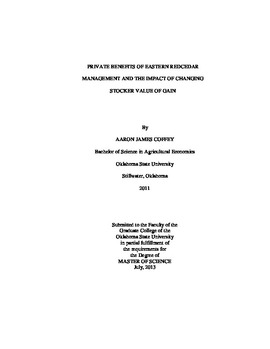| dc.contributor.advisor | Peel, Derrell S. | |
| dc.contributor.author | Coffey, Aaron James | |
| dc.date.accessioned | 2014-09-24T14:18:27Z | |
| dc.date.available | 2014-09-24T14:18:27Z | |
| dc.date.issued | 2013-07-01 | |
| dc.identifier.uri | https://hdl.handle.net/11244/11147 | |
| dc.description.abstract | The overall objective of this research is to determine the private benefits of eastern redcedar control and how those change with changing forage values. Eastern redcedar causes a reduction in forage availability for livestock producers. Three different management strategies are analyzed in this research over a 30 year period: no management, prescribed fire, and mechanical control plus prescribed fire. The research evaluates combinations of these management strategies to determine the maximum net present value of livestock production above redcedar control costs per acre during the 30 year management period.Impacts of eastern redcedar invasions are estimated by applying a generalized redcedar population growth model to a native range site in central Oklahoma. Reduction in forage available for livestock use is calculated from the canopy coverage resulting from the population of redcedar trees by age distribution. Maximum net present value per acre is determined for five levels of cedar invasion, using three levels of value of gain, for three types of stockers.Results show that prescribed fire is the predominant economically preferred eastern redcedar control alternative. Mechanical control was preferred only in situations of very heavy initial redcedar infestations and when the value of gain is very high. The economic analysis confirms that, while redcedar control after heavy infestations will restore a large percentage of the potential value for livestock production, controlling redcedar early to prevent invasion above management thresholds results in the highest net present value of livestock production. The research also shows that redcedar control is used more frequently and sooner when the value of stocker gain is higher. | |
| dc.format | application/pdf | |
| dc.language | en_US | |
| dc.publisher | Oklahoma State University | |
| dc.rights | Copyright is held by the author who has granted the Oklahoma State University Library the non-exclusive right to share this material in its institutional repository. Contact Digital Library Services at lib-dls@okstate.edu or 405-744-9161 for the permission policy on the use, reproduction or distribution of this material. | |
| dc.title | Private Benefits of Eastern Redcedar Management and the Impact of Changing Stocker Value of Gain | |
| dc.type | text | |
| dc.contributor.committeeMember | Bidwell, Terrence G. | |
| dc.contributor.committeeMember | Lalman, David | |
| osu.filename | Coffey_okstate_0664M_12827.pdf | |
| osu.accesstype | Open Access | |
| dc.description.department | Agricultural Economics | |
| dc.type.genre | Thesis | |
